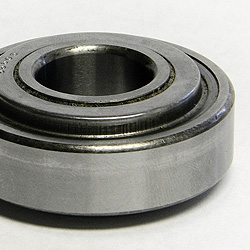Blog
What is a Self-Aligning Bearing?
July 18, 2017
Self-aligning bearings function as automatic imbalance compensators when ailing shafts deviate from their angular norm. Granted, the device looks much like a standard bearing. There are rings, rolling elements, and an empty middle section for a shaft. A closer look, though, reveals a curved inner surface on the outer ring, plus two sets of ball bearings. Just how does this unique device architecture correct misalignment errors?
Deflecting Angular Errors
The inner ring of a self-aligning bearing uses two grooves. Two sets of rolling elements then occupy those inner channels. Above the paired balls, a concave race surface glides along the spherical array. This is where the misalignment feature enters the mechanics of the design. Simply put, that outer ring, its curved inner surface, deflects ever so slightly when a shaft moves out of alignment. The inner ring accommodates the error, which is unavoidable since it’s coupled to the shaft, but the outer ring corrects that angular deviation by acting as a compensation ring, a component that deflects around the bearing axis. When this compensation action takes place, the radial imbalance is offset and the equipment housing avoids shaft movement stress.
Self-Aligning Bearing Benefits
Imagine the device operating when severe shaft imbalance is threatening a motor or power transmission train. The mounted rod is moving eccentrically, yet no damage occurs to the outer machine components. That inner ring and its twin set of ball bearings are paralleling the misalignment error, but the curved surface inside the outer ring is compensating for the jagged movement. Thanks to this design, continuous static misalignment problems are offset. Likewise, dynamic radial errors are counteracted, with the concave race skating axially up and down the spherical rollers in a sinusoidal manner so that the external parts remain unstressed and wear free. Frankly, that kind of wear is hard to avoid. The spinning parts cause wear, then vibrations aggravate the ageing effect until the coupling device connecting the power transmission train is pushed off centre. Fortunately, self-aligning bearings still operate properly when these mechanical forces have their way.
Self-aligning bearings leverage a property that lives inside every ball bearing. Built to race down the twin rings in a single direction, at right-angles to the shaft, the spheroid profile gains access to a second dimension when a concave surface is present on the outer ring. Aided by an extra set of balls, the outer ring imbues the device with the ability to move along a second axis. Of course, that deflection angle is small, but it’s more than enough to correct a shaft’s misalignment problems while quietly delivering thrust-free performance.
Optimized by: Netwizard SEO

